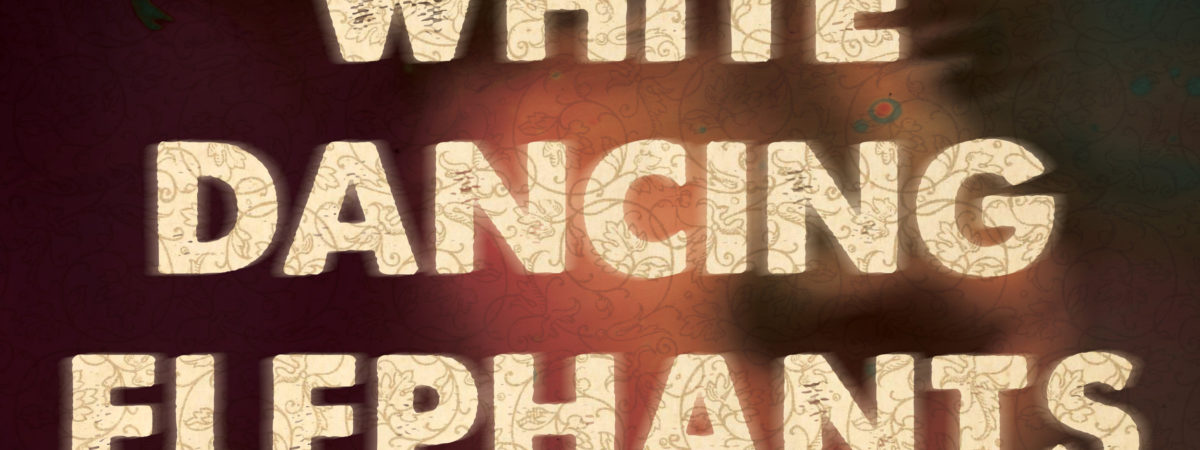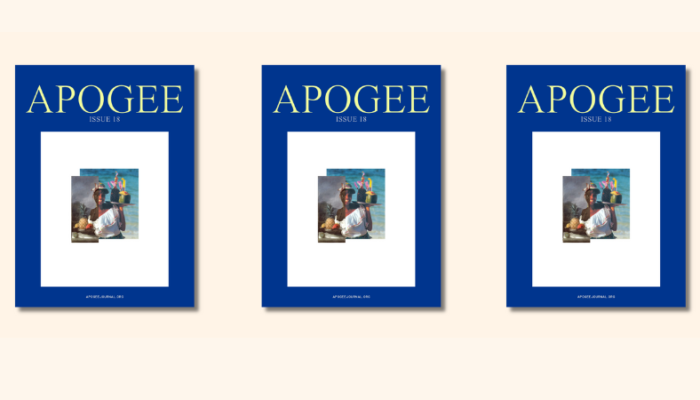An Interview with Chaya Bhuvaneswar
I met Chaya Bhuvaneswar on Twitter where she tirelessly champions other writers, especially women of color. I felt cheered by her enthusiasm and I looked forward to the publication of her debut story collection, White Dancing Elephants, which was selected as the winning manuscript in the 2018 Dzanc Prize for Fiction. Then I read her book, and became a fan. Chaya’s stories are dark, weird, often funny, the characters and lifestyles acutely observed, her language sharp as an arrow. Take this description of a mother and father given by the couple’s artistic and mentally disabled adult son who narrates the story, “Jagatishwaran”: Mother used to come at night, years ago, before I put up the screens, to ask how I was, but now she’s afraid. Once I pushed him hard, not her, never her, and I felt disgust at his shriveled skin, his nasal voice, always skeptical, his tiny well-read eyes like an elephant’s, nearly blind but remembering everything.
The characters in White Dancing Elephants all have some type of violence or cruelty visited upon them, whether it is infertility, gang rape, a friend committing adultery with her dying bestie’s partner, or a husband building and keeping an artificially intelligent mistress. While the violence is specific, gendered, and cultural, the use of mythic references and poetic language transform the stories from their temporal location to an experience that readers recognize. Everything we’ve done is hurting her, the narrator of “Talinda” says. It’s a sentiment we all know, both as victims and perpetrators.
In the upcoming months, Chaya will be at the Winter Institute in Albuquerque, at AWP in Portland, the Virginia Festival of the Book, the American Library Association Conference in DC, the Yale Writers Workshop, and at several bookstores nationwide. I got to speak to her about her craft and the one question she would most like to answer.
— Renee Simms
Renee Simms: Many have hailed 2018-19 as a renaissance year for story collections by writers of color. What attracts you to the short story as a genre?
Chaya Bhuvaneswar: There is a definite sense of freedom and possibility. When I write down the first sentence, I already have a sense of “what happens” in the story but not at all how the characters get there. That may be true for other forms of writing as well, but in a short story, I could find out the “how” in just a few days or weeks, maybe even a single afternoon for a full first draft.
I also like the scope to experiment but not lose the intensity, or the reader. I am less forgiving of a certain degree of novelistic experimentation that makes it hard for me to sustain interest in a single character for 200 or more pages. I need a story, a relationship, a human soul, to be delineated in a way I recognize from reading many novels. With a short story, suddenly I’m in the middle of something that I don’t understand, but I want to stay, I still don’t want to leave. Like Kelly Link’s wonderful, strange story, “The Faerie Handbag,” which both thrilled and frightened me. Or like the title story in Nana Kwame Adjei-Brenyah’s Friday Black, which makes you in an odd way want to be there, in that zombie-invaded retail space, hanging out with the narrator of the story who against all odds, is such a good (and charismatic) guy.
Also, I like the compression that nonetheless gets you into an entire world. Like opening the wardrobe and landing straight in Narnia, in The Lion, the Witch, and the Wardrobe. Only, in a short story, the door of the wardrobe opens right away, to put you in the story’s central world, and in just seconds, the witch’s sled is nipping at your heels, and then in minutes, you’re rolling over and over in the snow and falling asleep before a fire. You can not only get inside a world immediately, by reading a short story, but you consume, and suffer from, all the delights in that world, immediately, sometimes concurrently.
RS: What you’ve mentioned—intensity and a compelling predicament—perfectly describe your story “Talinda.” For me, “Talinda” represents everything I love in well-crafted fiction. It drives on the sentence level with a clear command of language, plenty of clauses and surprising diction. And it drives on the story level with an interesting plot and a quirky first-person narrator. Can you talk about any of these qualities in your writing? Who do you read to learn how to craft sentences, for example?
CB: I think reading and memorizing poetry, as well as studying languages, lends so much to how we become attentive to craft. I studied German for several years and enjoyed reading books like Parsifal and Rilke’s poetry for how it made me bear down on every word. I’ve always read a lot of poetry and tried memorizing some in English but as part of practicing as a Hindu, memorizing Sanskrit poetry or slokas was part of South Indian practice and that turned my ear to language early on. I studied Sanskrit which was so intense, it convinced me I could learn the “language” of medicine – and that has been exhilarating, learning to look closely at words, to understand the clinical meanings of words, in a different way than I probably would have, had I only been a lit major, though I love talking to friends who were lit majors and who teach lit now, like my high school friend Dohra Ahmad whose book Rotten English, a wonderful anthology, I strongly recommend for how many far flung varieties of “English dialect” it encompasses, from all corners of the globe.
One ‘craft note” about fiction writing I can pass on: it can feel like a real tussle to move between a plot that really has a pulse, that moves with big gestures, that is really alive and not overly self-conscious and that feels like real life == versus crafting every word, every sentence and making each sentence look beautiful. It can constrict a story to get overly focused on sentences. Similarly, I flinch a little when I read a book with a really fast paced, engrossing plot that didn’t pay the same attention to language.
I think it’s important to trust the revision process and “get things out” however they come out. Sometimes it’s going to be that you hear a lot of ‘musical phrases’ and you have to write what you hear, then set it aside and write big “treatments,” like for a movie, where you really diagram the script and it’s almost like you’re drawing it rather than writing it on a sentence by sentence level. Sometimes it’s going to be that the story really grips you and pours out and you have to make yourself go back and refine each sentence, each word. Both modes of writing can even happen while you’re generating a single manuscript. But you have to trust to it. Not question that the plot is galloping forward, but you feel like the prose could be more polished. Polish afterwards. Not question whether you’re being “too mannered” or “too pretty,” because maybe letting that music come out, or letting the voice of a character hold forth, is what leads you to better understand what actually happens to that character, and thereby what your story is about.
RS: Can you talk about polishing or structuring White Dancing Elephants? And then share how you felt once you’d learned you won the Dzanc prize?
CB: I would say I’m learning as I go. For this book, I approached it really instinctively, and on the level of wanting variation (avoid long sequences of all first-person present stories, try to include some of the longer stories up front while you have maximal attention from reader). It was like putting together a mix tape, like we did in elementary school.
For other books, I am excited to learn more about structure – whether the chapters of a novel or the sequencing of a linked story collection. I feel like diagramming favorite books, whether Tracks or Beloved, helps a lot with structure. So did diagramming Possession, which I like more for its structure than its characters.
I was happy and grateful to learn I’d won the Dzanc prize, but (I hate to admit this), one of the first thoughts I had was, “What should I try and publish next, after this one?”
RS: What can we expect from you?
CB: I really hope my novel gets picked up. Can I say that so directly? I am certain many will identify. I am nervous but thrilled and above all grateful that it is going to be submitted, that it exists.
RS: You’ve published a critically-acclaimed story collection and you have a working draft of a novel, but you also practice medicine. How has the practice of medicine shaped you as an author?
CB: It’s definitely lent me some degree of perseverance, the ability to tolerate a lot, the willingness to keep trying to be heard, trying to be understood. And certainly, the practice of medicine above all nurtures me in caring for, and taking a strong interest in other people’s lives, which is so relevant to writing fiction, in which the characters have “lives of their own.”
RS: Who are women writers that you’d recommend?
CB: Wow – so many. Jhumpa Lahiri, Rachel Cusk, Lauren Groff, JK Rowling, Lydia Kiesling, the Bronte sisters, Louise Erdrich, Maya Angelou, Carson McCullers, Flannery O’Connor, Alice Munro, Kelly Link, Kelly Luce, Amelia Gray, Jimin Han, Esme Waijun Wang, Porochista Khakpour, Morgan Jerkins, Julie Buntin, Claudia Dey, Sari Botton, Maggie Smith, Natalie Diaz, Jaquira Diaz, Kathy Wang, Lisa Ko, Maxine Hong Kingston, Fae Myenne Ng, Nadine Gordimer, Anita Brookner, Cherrie Moraga, Julia Alvarez, Chimamanda Ngozi Adichie, Edwidge Danticat, Nicole Sealey, Elizabeth McCracken, Maaza Mengiste, Bharati Mukherjee.
RS: What question would you most like to answer?
CB: Do you think there are parallels between the experiences of women of color from different communities, different cultures? Is the identity “woman of color” a meaningful and real one, speaking of abiding solidarity? Hell to the yes. Thanks, and good night.
Chaya Bhuvaneswar is a practicing physician and writer whose work has appeared or is forthcoming in Narrative Magazine, Tin House, Electric Lit, The Rumpus, The Millions, Joyland, Large Hearted Boy, Chattahoochee Review, Michigan Quarterly Review, The Awl, jellyfish review, aaduna and elsewhere, with poetry in Cutthroat, sidereal, Natural Bridge, apt magazine, Hobart, Ithaca Lit, Quiddity and elsewhere. Her poetry and prose juxtapose Hindu epics, other myths and histories, and the survival of sexual harassment and racialized sexual violence by diverse women of color. IN addition to the Dzanc Books Short Story Collection prize under which her debut collection WHITE DANCING ELEPHANTS will be released on Oct 9 2018, she recently received a MacDowell Colony Fellowship and a Henfield award for her writing. Her work received several Pushcart Prize anthology nominations this year as well as a Joy Harjo Poetry Contest prize. Follow her on Twitter at @chayab77 including for upcoming readings and events.
Renee Simms debut story collection is Meet Behind Mars. Her fiction can also be found in Callaloo, Oxford American, Ecotone, Literary Hub, Southwest Review, North American Review, The Rumpus, Salon and elsewhere. She’s received fellowships from the National Endowment for the Arts, Bread Loaf, Ragdale, Vermont Studio Center, Kimbilio, PEN Center, and Cave Canem. She is an associate professor of African American Studies and affiliate faculty of English Studies at University of Puget Sound in Tacoma.




